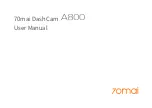
1-2
Cisco Video Surveillance 2500 Series IP Camera User Guide
OL-19273-02
Chapter 1 Overview
IP Camera Physical Details
•
Syslog support—
The IP camera can send log data to a Syslog server.
•
IP address filter—
You can designate IP addresses that can access the IP camera and IP addresses
that cannot access the IP camera.
•
User-definable HTTP/ HTTPS port number—
Allows you to define the port that is used to
connect to the camera through the Internet.
•
DHCP support
—The IP camera can automatically obtain its IP addresses in a network in which
DHCP is enabled.
•
Network Time Protocol (NTP) support—
Allows the IP camera to calibrate its internal clock with
a local or Internet time server.
•
Support for C and CS mount lenses
—Supports a variety of C and CS mount lenses.
•
RS-485/PTZ support
—Supports Pelco D protocol, which enables PTZ functions when used with a
supported motorized zoom lens, external pan/tilt mount, and control device.
•
Power options
—The wired IP camera can be powered with 12 volts DC, which is provided through
an optional external power adapter, or through PoE (802.3af), which is provided through a supported
switch; the wireless IP camera does not support PoE and requires an external power adapter.
•
Camera access control—
You can control access to IP camera configuration windows and live video
by configuring various user types and log in credentials.
•
Cisco Media API
—The IP camera supports the open, standards based, Cisco Media Application
Programming Interface.
•
Wireless support
—The wireless IP camera is compatible with networks that conform to the
IEEE802.11b or IEEE802.11g specifications.
IP Camera Physical Details
The IP camera includes a reset button, built-in microphone, status LEDs, several ports for connecting
external devices, and two threaded mounting holes, one on the bottom and one on the top.
Figure 1-1
and the table that follows describe the items on the front of the IP camera.









































